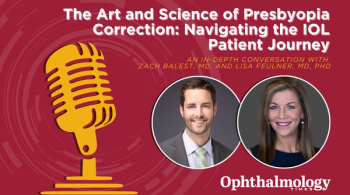
Trabeculectomy offers better long-term IOP control than deep sclerectomy
Although trabeculectomy and deep sclerectomy provide long-term IOP reduction in patients with open-angle glaucoma, trabeculectomy is more effective than deep sclerectomy in achieving IOP less than or equal to 16 mm Hg with or without goniopuncture, reported Stefano A. Gandolfi, MD.
May 3
- Fort Lauderdale, FL - Although trabeculectomy and deep sclerectomy provide long-term IOP reduction in patients with open-angle glaucoma, trabeculectomy is more effective than deep sclerectomy in achieving IOP less than or equal to 16 mm Hg with or without goniopuncture, reported Stefano A. Gandolfi, MD.
In a 7-year, prospective, randomized clinical trial, 79 eyes of 79 patients were randomly assigned to either deep sclerectomy or trabeculectomy. Patient outcomes were considered efficacious if the IOP was equal to or less than 21 mm Hg. Failure was defined as an IOP greater than 21 mm Hg, which did not respond to bleb needling and/or supplementation with subconjunctival 5-fluorouracil (5-FU) within the 4-month postoperative period, explained Dr. Gandolfi, of the University of Parma, Italy.
In the deep sclerectomy group of 41 eyes, there were two complete failures at the time of the procedure. Nineteen eyes had good long-term IOP control and 20 eyes required YAG-laser goniopuncture. In terms of IOP target pressure, 43% of the deep sclerectomy eyes reached the 21 mm Hg mark, 18% were lowered to the 18 mm Hg target, and only 3% achieved the 16 mm Hg point.
In the trabeculectomy group of 38 eyes, there was one complete failure at the time of the procedure. Twenty-six eyes were considered a complete success with good long-term IOP control. In terms of IOP target pressure, 68% of the trabeculectomy eyes achieved the 21 mm Hg point, 51% reached the 18 mm Hg point, and 45% were maintained at 16 mm Hg. However, 19 eyes in the trabeculectomy group had to undergo phacoemulsification.
"Trabeculectomy was associated with increased incidence of cataract and the need for cataract extraction," he said.
Newsletter
Don’t miss out—get Ophthalmology Times updates on the latest clinical advancements and expert interviews, straight to your inbox.
















































.png)


